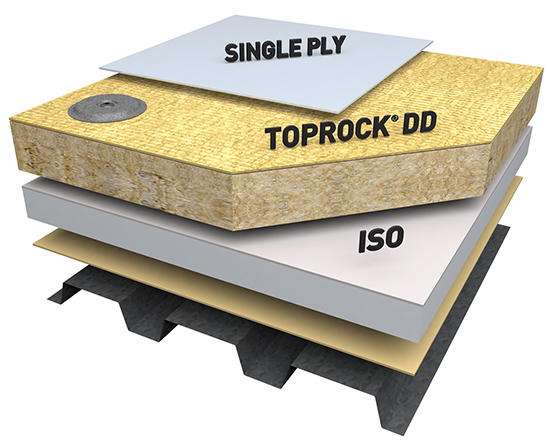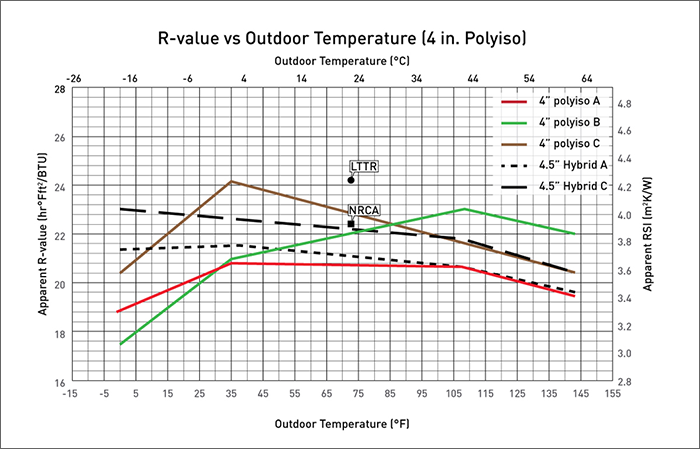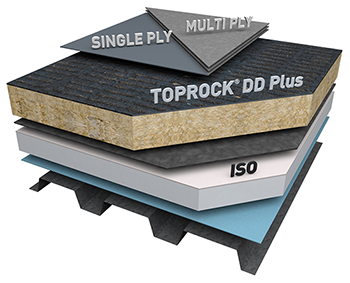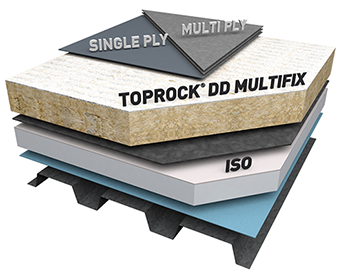With the goal of reducing negative environmental effects and working toward greater sustainability, building codes are tightening across North America. The focus is shifting to better building practices and products to achieve more efficient and effective building envelopes.
According to the U.S. Green Building Council, the global building stock currently is responsible for 40 percent of the world's carbon monoxide emissions, and exhaust from using fossil fuels to heat and cool buildings is a major contributor to the world's carbon footprint. Improving buildings' energy efficiency by adding effective insulation can drastically reduce emissions and, as a result, lessen human reliance on fossil fuels and contribute to the preservation of the environment.
Stone wool insulation is one commonly used material for a number of building envelope applications that complies with building code requirements and helps deliver efficiencies for commercial, low-slope roof systems.
Stone wool insulation
In North American commercial low-slope roof assembly applications, foam plastic insulations typically have been used because of their high thermal resistance and availability. During the past eight years, stone wool insulation products have been offered as an alternative with full-height stone wool or hybrid (stone wool over foam insulation) options available. Despite stone wool's lower R-value per inch than foam plastic insulations, the stone wool options answer the recent building science research question about the actual thermal performance of foam insulations based on temperature.
Stone wool provides benefits other than energy efficiency to create value for occupants and owners such as superior fire-resistance properties, sound resistance, dimensional stability (which results in less movement under the roof membrane with negligible shrinkage), vapor permeability and effective R-values across a wide range of temperatures.
Passive fire resistance, which provides continuous performance rather than active systems such as sprinklers that only are used when a fire occurs, is a major benefit of stone wool-based roofing and wall products as they can limit the damage to a structure in the event of a fire; stone wool can withstand temperatures up to 2,150 F. Stone wool-based roofing products also can benefit building owners by potentially allowing them to become eligible for lower insurance premiums based on passive fire-resistant construction. Note that using all stone wool roof systems will increase the height and weight of roof systems because of the thermal requirements and increased mass. Although stone wool provides additional benefits to roof systems, its weight must be accounted for during the budget and design process.
Redefining cover boards
There is a cost-effective way to incorporate fire-resistant stone wool products into roofs. This often is referred to as a "hybrid" or "dual" insulation strategy.
In North America, typical roof systems incorporate a cover board placed over two or three layers of polyisocyanurate insulation to meet the high thermal-resistance requirements of building energy codes. In these configurations, the cover board mainly is required as a transition layer between the main insulating layers and waterproof membrane.
There are two well-known challenges to this traditional system: The effective R-value of common polyisocyanurate insulation is inconsistent across a wide range of temperatures because R-value drops at colder temperatures and a traditional cover board, which comes in thicknesses of 1/4, 1/2 or 1 inch and is used to provide a suitable substrate to which membranes can adhere, provides little thermal resistance combined with potential system-damaging hydrophilic properties by nature. This can reduce a roof system's longevity, for example, in the event of a water leak. A cover board losing its integrity is another frequent cause of roof failure because of condensation occurring under a roof membrane.
Insulation manufacturers publish statements that show product R-values at 75 F, which may not be indicative of effectiveness at other temperatures, especially when products' insulating properties change dramatically at various temperatures. Using published R-values as design R-values is not always accurate and can lead to issues with mechanical equipment sizing and owners not achieving heating and cooling cost targets.
The R-value of stone wool insulation—though lower than the R-value of polyisocyanurate insulation at 75 F—is not significantly affected by temperature and also increases in colder environments. On the other hand, common polyisocyanurate insulation R-values can drop significantly in colder and hotter temperatures.
ASTM C726-12, "Standard Specification for Mineral Wool Roof Insulation Board," recommends testing the insulation material at a mean temperature of 75 ± 2 F and 40 F minimum temperature gradient across the thickness of the test specimen or at a mean temperature agreed upon between the purchaser and manufacturer (some typical additional mean temperatures are 25 F and 110 F) using one of the standard test methods for steady-state thermal transmission properties to give a better representation of the in-situ performance of an insulation material. Other insulation manufacturers could provide their results at these temperature points to provide designers and contractors with relevant information for their climate zones.
Numerous test results and research papers have been published about this topic by recognized organizations and laboratories such as NRCA; Building Science Corp., Westford, Mass.; and RDH Building Science, Vancouver.
Practical application
Because of this temperature-dependant R-value phenomenon, a hybrid strategy using a stone wool product as a thicker cover board over polyisocyanurate (having each equal roughly 50 percent of the required thermal resistance) results in an effective overall system with increased thermal performance (see Figure 1). With either insulation representing more than 50 percent of the thermal resistance, the negatives of each product outweigh the positives as the roof system will become thicker when more stone wool is used and the drop off at extreme temperatures is greater when more polyisocyanurate insulation is used.

Figure 1: Hybrid insulation strategy using polyisocyanurate and a ROXUL® stone wool cover board on a traditional steel deck and steel structure roof |
The insulating system provides energy and cost savings during cooling and heating seasons. Based on the ability of stone wool to perform consistently in a wide range of temperatures, a stone wool cover board allows the polyisocyanurate insulation below it to perform at its peak R-value by being maintained near room temperature, a range where the product R-value is at its highest.
Figure 2 illustrates this concept by showing the apparent R-value of three full-height polyisocyanurate roof systems and two hybrid roof systems that include 2 1/2 inches of stone wool and 2 inches of polyisocyanurate insulation. The apparent R-values of the full-height polyisocyanurate roof systems decrease as the temperature decreases whereas the apparent R-values of hybrid roof systems increase. To assist design professionals assessing the performance of the different systems, the ROXUL Energy Design Centre (EDC), a global network of building science specialists within the ROCKWOOL Group, offers support for comparison between hybrid and traditional roof insulating strategies and systems (among other free-of-charge assistance) in all regions across North America and throughout the world.

Figure 2: Apparent R-value of 4.5-inch hybrid insulation combinations at “in-service” temperature (Source: Building Science Corp., Westford, Mass.) |
By replacing a traditional cover board with a stone wool product, the insulating system performance is enhanced by a cover board material delivering a significantly higher R-value per inch while providing a hydrophobic cover board material. With minimal effect on overall roof thickness, a noncontributing layer to the thermal performance (the cover board) is replaced by a highly contributing layer to the thermal performance (the stone wool insulation board). This two-layer system becomes cost-competitive as the removal of the traditional cover board eliminates the cost for the application, adhesion and labor of a third layer; however, there will be an increase to the weight because of stone wool's increased mass. Figure 3 illustrates two examples of roof systems with a hybrid insulation strategy.
In addition, to accommodate the increasing R-value requirements in building codes, a stone wool cover board can be used in any thickness from 2 to 6 inches. In regions where R-20 or more is required, this hybrid system offers an ideal solution for designers. By using a hybrid approach, a building can save a significant amount of energy for heating and cooling resulting in a quicker payback period for a premium roof system. A hybrid roof insulation strategy not only can comply with design R-value requirements for replacement, new construction and reroofing projects, but it also can provide more effective energy savings based on less temperature dependency.

|

|
|
Figure 3: Two examples of hybrid insulation strategies |
|
When the stone wool is used on top of polyisocyanurate, the stone wool moderates the relative temperature of the polyisocyanurate so it is kept near its optimal temperature range, which is closer to the 75 F mean temperature widely reported. By using a hybrid approach, the height of a roof system may increase depending on the thermal requirements and there may be a need to evaluate the load requirements of the roof system.
An alternate approach
With a hybrid or dual insulation approach—coupling polyisocyanurate with the numerous benefits of stone wool insulation such as fire resistance, vapor permeability, sound absorption, thermal lag, ease of installation and dimensional stability—the focus is on the ability of a roof system to perform as intended and be designed across a wide temperature range while remaining cost-effective.
Andrew Lindley is segment manager—roofing for ROXUL Inc., Milton, Ontario.



